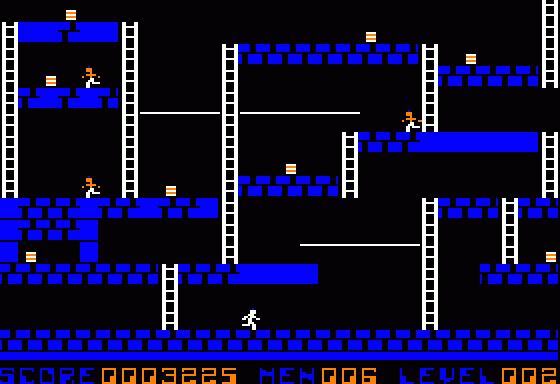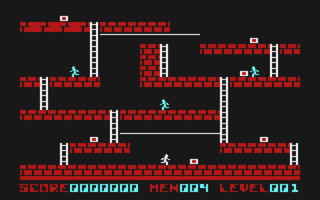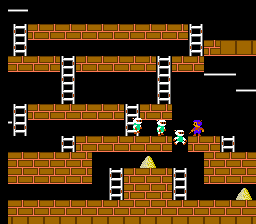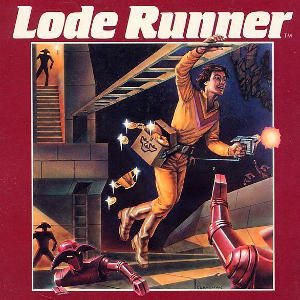Overview

Lode Runner is a single-screen puzzle-platformer developed by Doug Smith and published by Brøderbund Software for the Apple II on June 23, 1983.
In Lode Runner, players guide a spelunker around an underground treasury, collecting treasure and attempting to escape while avoiding the guards pursuing them. The original game's lore ties it with the earlier Choplifter! and the later Raid on Bungeling Bay, with the player as a futuristic Galactic commando infiltrating the underground treasury of the Bungeling Empire to recover the people's fortune.
While they cannot dodge using leaping jumps, nor use direct weaponry against the guards, the spelunker is armed with a laser drill pistol that allows them to drill the ground beside them, creating temporary passageways that allow them to safely pass through (allowing them to reach certain treasure or escape from guards) or trap enemy guards (which cause them to drop gold they carry, and can collapse on them to temporarily remove them from the game). Along with 150 levels, the game features a built-in level editor for custom puzzles (one of the earliest known games to do so).
The game received licensed conversions to numerous computers in the mid-1980's throughout the world, as well as the Nintendo Entertainment System and Sega SG-1000 consoles. It was known for its popularity in Japan, which was rare for a Western-developed game at the time. Although the original version was the only one with involvement by Smith himself, the series received multiple sequels and spin-offs by different studios, including Broderbund's only sequel (the expert standalone level pack Championship Lode Runner).
Gameplay

The object is to collect all the gold in a level then get to the exit at the top of the level. The challenge lies in the level design and various enemies spread throughout. The only way to combat the enemy is to dig holes in the ground for them to fall into and get temporarily trapped, there was no jumping. The levels contain only brick 'ground', ladders and overhead bars.
Even though it is a 2D platform game it is as many parts puzzle game. The level and enemies are designed to test a player mentally and physically, with problem solving and quick reactions needed to clear the more dastardly levels.
Ports & Re-releases
It received ports at the time by Broderbund to the Commodore 64, Atari 8-bit computers, Commodore VIC-20, Macintosh, and IBM PCs. It also received licensed ports for the NEC PC-98, NEC PC-88, NEC PC-6000, MSX, FM-7, Sharp X1, Sharp X68000, Family Computer, and Sega SG-1000 in Japan, and for the ZX Spectrum, BBC Micro, Amstrad CPC, and Atari ST in Europe. It later received a mobile port on Android, iOS, and Windows Phone as Lode Runner Classic. The game also received four licensed arcade releases by Irem, each with a different assortment of levels: Lode Runner, Lode Runner: The Bungeling Strikes Back, Lode Runner: Majin no Fukkatsu, and Lode Runner: Teikoku Kara no Dasshutsu.
NES Version

The Japanese Famicom version was developed and released by Hudson Soft, later receiving a North American NES release on September 1987.
One of the most well-known conversions of the game, it features larger scrolling levels and a guard design that was later reworked into the player character of the NES version of Bomberman (which would become the series' staple design). Several other Japanese conversions were based on the this version, with the X68000 version being a direct port.
This verison was later released digitally as a Virtual Console title, first for the Wii in 2007 and 2010, then for the Wii U in 2014 and 2015. It was also released for the Game Boy Advance in Japan in 2005, bundled with the Famicom version of Championship Lode Runner as Hudson Best Collection Vol. 2: Lode Runner Collection.

 Apple II
Apple II Wii Shop
Wii Shop PC
PC iPhone
iPhone Android
Android Windows Phone
Windows Phone Wii U
Wii U





























